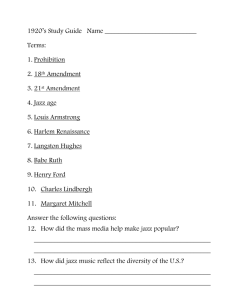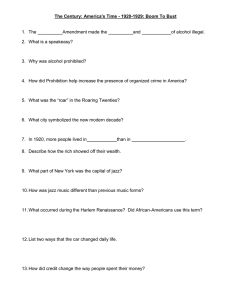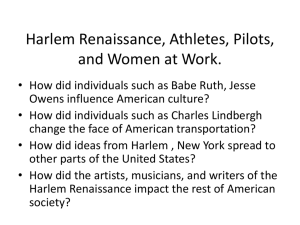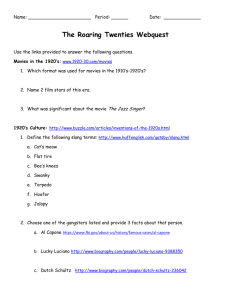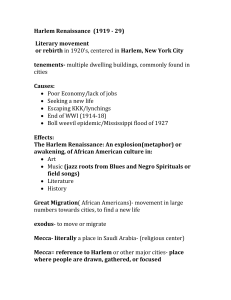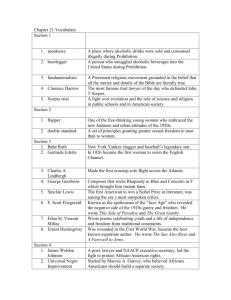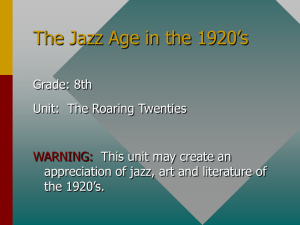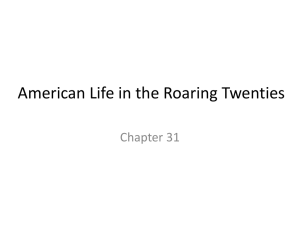Lusitania
advertisement
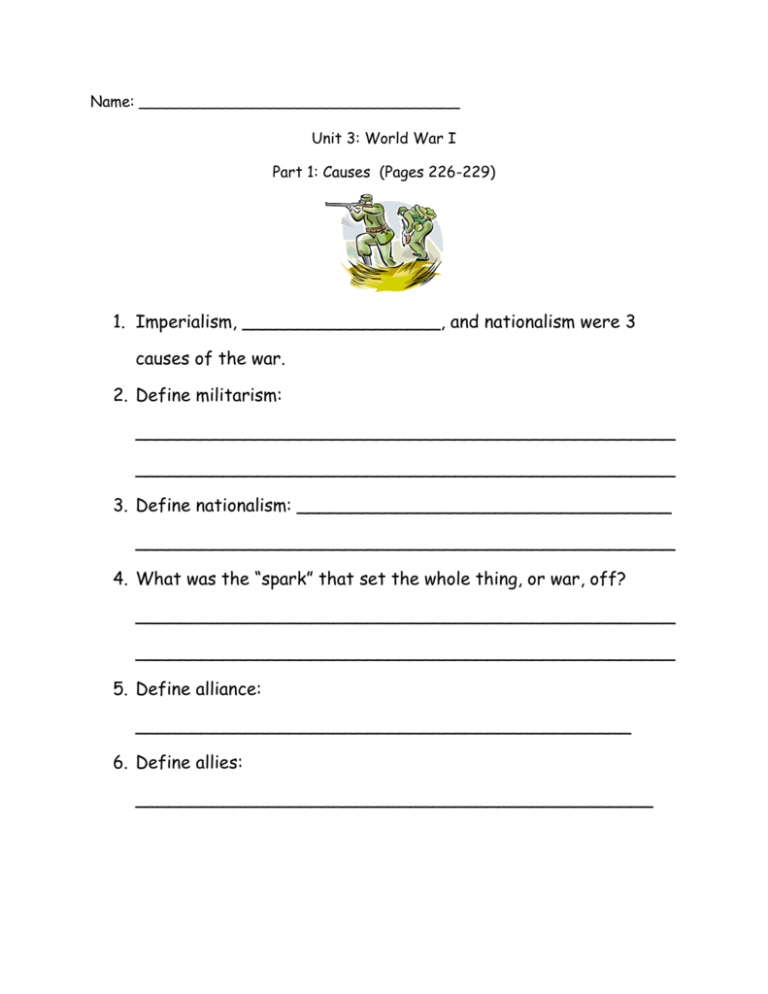
Name: __________________________________ Unit 3: World War I Part 1: Causes (Pages 226-229) 1. Imperialism, __________________, and nationalism were 3 causes of the war. 2. Define militarism: _________________________________________________ _________________________________________________ 3. Define nationalism: __________________________________ _________________________________________________ 4. What was the “spark” that set the whole thing, or war, off? _________________________________________________ _________________________________________________ 5. Define alliance: _____________________________________________ 6. Define allies: _______________________________________________ 7. The Allied Powers were made up of the countries of : a. ________________________ b. ________________________ c. ________________________ d. ________________________ e. ________________________ f. ________________________ 8. The Central Powers were made up of: a. ________________________ b. ________________________ c. ________________________ d. ________________________ 9. President Teddy Roosevelt believed in imperialism. However, the next president did not. Taft believed in ___________________ which was ________________________________________ ________________________________________________. Woodrow Wilson, who was the next president and president during the war believed ________________________________________________. 10. World War I began in the year _____________________. The next few years, the U.S. was _____________________. 11. What was the Lusitania and what happened to it? _________________________________________________ _______________________________________________ 12. Why did the U.S. decide to enter the war with Germany? (3 reasons) a. _____________________________________________ b. _____________________________________________ 13.When did the U.S. enter the war? ___________________ 14.How did the U.S. become prepared for war? _________________________________________________ _________________________________________________ 15.Define military draft: ________________________________________________ ________________________________________________ Part 2: The War Years (Pages 234-239) 1. How did soldiers fight before this time? _________________________________________________ 2. World War I would be fought on land, at sea, and ________________________________________________. 3. New weapons included: a. ________________________ b. ________________________ c. ________________________ d. ________________________ 4. Define trenches: ____________________________________ 5. The area between the trenches was known as __________________________________. 6. The Germans used submarines called ___________________ as part of their navy. 7. To fight the German U-boats, the Allies used: a. _____________________________________________ b. _____________________________________________ 8. Planes were now used for scouting and as weapons of war because ______________________________ were mounted to them. 9. How did the war help the American economy? a. ____________________________________________ b. ____________________________________________ c. ____________________________________________ d. ____________________________________________ 10. How did the U.S. factories help meet the needs of the war? ____________________________________________ 11. The people of the U.S. helped meet the needs of the war by using less: a. _______________________ b. _______________________ 12. Citizens also loaned the government money by buying ____________________. 13. Since the number of immigrants dropped during the war, _________________________ and ____________________ helped fill the jobs left empty by the men who went to war. 14. Name 2 groups that helped to make the lives of the soldiers better. ___________________________________________ 15. Name 3 jobs women did in the military: _______________ _________________________________________________ Part 3: The End of the War and Post-War America (Pages 239-241) 1. How did the U.S. surprise both sides of the war? __________ _________________________________________________ 2. What happened in 1918 that caused a greater need for U.S. troops? _________________________________________ 3. Russia’s new government was called ____________________. This means ______________________________________ ______________________________________________. 4. When did the war end? _____________________________ 5. What was this day called? ___________________________ 6. Who won? _______________________________________ (Pages 242-245) 7. The president’s peace ideas were called ______________________________________________. 8. 4 major points were: a. ___________________________________________ b. ___________________________________________ c. ___________________________________________ d. ___________________________________________ 9. Some countries were not as worried about peace as they were with ___________________________________________. 10. 30 countries met near Paris to sign the peace treaty called ______________________________________________. 11. The treaty said that ______________________ was responsible for the war and it should ___________________ ______________________________________________. 12. Trying to pay for the damages left Germany _________. They had to repay some of this debt in _______________. 13. President Wilson wanted to form ___________________ _________________________. This group of countries would work together for world peace. Did the U.S. join? _____ 14. When soldiers returned home after the war, what problem did this cause? ______________________________________. 15. The demand for war supplies ended. What 2 things happened to workers?________________________________________ _________________________________________________ Part 4: The 1920’s 1. The 1920s were known as the _____________________ or the ________________________________. 2. Jazz was music that came from ______________________. It was a mix of the ___________ and ___________________. 3. How did Jazz make its way North? _________________ ________________________________________________ 4. Americans found new form of entertainment, including: a. ___________________________________ b. ___________________________________ c. ___________________________________ d. ___________________________________ 5. __________________ earned the right to vote with the passing of the 19th amendment. 6. More people were __________________________ than ever before. Harlem Renaissance 7. Harlem is a section found in ___________________________. 8. It is rich in _________________________ heritage. 9. Renaissance means ___________________________. It was in culture of African Americans from 19___ to the 19___s. 10. One reason for this was the ______________________. 11. The common themes of this area and time were ____________ and ______________. 12. Langston Hughes was a famous ________________ who had a very emotional, joyful style of writing. Louis Armstrong 13. He was born in _______________________ which was also where jazz was born. 14. He was said to have ______________ in his voice. 15. He sang and played the _____________________. 16. He was known for his _________________ and a white _________________ that he waved while singing. 17. “___________________” is what it was all about. Babe Ruth 18. Babe’s real name was _________________________________. 19. He was famous in the sport of _______________________. 20. He played for the Boston Red Sox, but was sold to ____________ __________________________. 21. His nicknames were the “Great Bambino” and the “Sultan of Swat” which he earned by becoming the __________________ king. 22. He hit a record of ________ homeruns during his career. 23. Because he drew so many fans, they could afford to build Yankee Stadium. They called it ___________________________________. 24. He was great at bat, but was also an amazing ________________. 25. When he retired from baseball, he played ______________. Charles Lindbergh 26. Charles Lindbergh was an ________________________. 27. He set a ________________________ record for flying from California to New York. 28. He entered the transatlantic race to fly from ______________ to __________________ alone. The 3,600 mile flight took him _____ hours. He won $____________________. 29. He was greeted in Europe and the U.S. with ______________, speeches, and _________________. 30. Later he worked with the Air Force to _____________________ _____________________________. Henry Ford 31.He did not invent the automobile, but he ________________________________________________. 32. When cars were first invented, they were considered only ____________________________________________. 33. His first car was called the ___________________________. 34. He could produce a car in ______ minutes. 35. He is known for starting the ________________________ in 1903. 36. His hero was his friend __________________________. 37. His greatest idea was the __________________________. This helped to mass produce cars more quickly which made them more affordable. 38. He was fair to his workers and was one of the first to pay $____ per day.
